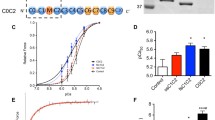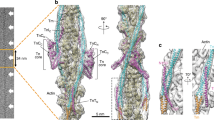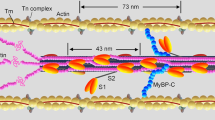Abstract
Phosphorylation of the regulatory light chain subunit of smooth muscle myosin is sufficient, but not necessary for muscle contraction. It has been suggested that thin-filament regulation may also contribute to the regulation of contraction. A hallmark feature of regulated thin filaments, previously described for vertebrate skeletal muscle, is the capacity of strong-binding or rigor-like cross bridges to “turn-on” the actin filament. Turned-on thin filaments stimulate cross-bridge attachment even in the absence of calcium. The present study utilized an in vitro sliding-filament motility assay to test for thin-filament regulation of both unphosphorylated and phosphorylated smooth muscle myosins. Regulated thin-filaments were reconstituted from skeletal muscle actin and chicken gizzard smooth muscle tropomyosin (TmCG), and then turned-on either (1) by rigor cross bridges at low concentrations of MgATP, or (2) by adding N-ethyl-maleimide-modified skeletal subfragment S1(NEM-S1), which forms rigor-like bonds in the presence of MgATP. For control actin·TmCG filaments, force production by unphosphorylated myosin was 0.5% of that produced by thiophosphorylated myosin. The force exerted on actin·Tm filaments by both unphosphorylated and phosphorylated myosins was increased by reducing the [MgATP] to 10–100 μM MgATP (rigor-dependent activation). Force was also increased by actin·TmCG filaments that had been turned-on by NEM-S1 binding, with force production by unphosphorylated myosin increased 80-fold vs. 2.3-fold for thiophosphorylated myosin. TmCG was required for increased force production with both low MgATP and NEM-S1. Unloaded filament velocity for NEM-S1-activated thin filaments was 0.72 μm/sec with unphosphorylated myosin compared to 1.24 μm/sec with thiophosphorylated myosin. Taken together, these results suggest that thin-filament regulation may play a role in the activation of both unphosphorylated and phosphorylated smooth muscle myosins and suggest a possible mechanism for activation of slowly cycling unphosphorylated cross bridges (i.e. latch-state) during tonic contractions of smooth muscle.
Similar content being viewed by others
References
Adam LP, Haeberle JR and Hathaway DR (1989) Phosphorylation of caldesmon in arterial smooth muscle. J Biol Chem 264: 7698-7703.
Bremel RD and Weber A (1972) Cooperation within actin filament in vertebrate skeletal muscle. Nature New Biology 238: 97-101.
Butler TM, Siegman MJ and Mooers SU (1986) Slowing of cross-bridge cycling in smooth muscle without evidence of an internal load. Am J Physiol 251: C945-C950.
Chacko S and Eisenberg E (1990) Cooperativity of actin-activated ATPase of gizzard heavy meromyosin in the presence of gizzard tropomyosin. J Biol Chem 265: 2105-2110.
Chalovich JM (1992) Actin mediated regulation of muscle contraction. Pharmacol Ther 55: 95-148.
Chatterjee M, Hai C-M and Murphy RA (1987) Dependence of stress and velocity on Ca2+ and myosin phosphorylation in the skinned swine carotid media. Progr Clin Biol Res. 245: 399-410.
Dillon PF and Murphy RA (1982) Tonic force maintenance with reduced shortening velocity in arterial smooth muscle. Am J Physiol 242: C102-C108.
Grazi E and Trombetta G (1991) Evidence that unphosphorylated smooth muscle myosin supports smooth muscle contraction. Biochem Biophys Res Commun 178: 967-973.
Greene LE, Williams DL and Eisenberg E (1987) Regulation of actomyosin ATPase activity by troponin-tropomyosin: effect of the binding of the myosin subfragment 1 (S-1)ATP complex. Proc Natl Acad Sci USA 84: 3102-3106.
Guilford WH, Dupuis DE, Kennedy G, Wu J, Patlak JB and Warshaw DM (1997) Smooth muscle and skeletal muscle myosins produce similar unitary forces and displacements in the laser trap. Biophys J 72: 1006-1021.
Haeberle JR, Hott JW and Hathaway DR (1985) Regulation of isometric force and isotonic shortening velocity by phosphorylation of the 20,000 dalton myosin light chain of rat uterine smooth muscle. Pflugers Arch 403: 215-219.
Haeberle JR, Trybus KM, Hemric ME and WARSHAW DM (1992) The effects of smooth muscle caldesmon on actin filament motility. J Biol Chem 267: 23001-23006.
Haeberle JR (1994) Calponin decreases the rate of cross-bridge cycling and increases maximum force production by smooth muscle myosin in an in vitro motility assay. J Biol Chem 269: 12424-12431.
Haeberle JR and Hemric ME (1995) Are actin filaments moving under unloaded conditions in the in vitro motility assay? Biophys J 68: 306s-311s.
Hai C-M and Murphy RA (1988a) Regulation of shortening velocity by cross-bridge phosphorylation in smooth muscle. Am J Physiol 255: C86-C94.
Hai C-M and MURPHY RA. (1988b) Cross-bridge phosphorylation and regulation of the latch state in smooth muscle. Am J Physiol 254: C99-C106.
Hathaway DR and Haeberle JR (1985) A radioimmunoblotting method for measuring myosin light chain phosphorylation levels in smooth muscle. Am J Physiol 249: C245-C251.
Hill TL, Eisenberg E and Greene LE (1980) Theoretical model for the cooperative equilibrium binding of myosin subfragment 1 to the actin-troponin-tropomyosin complex. Biochemistry 77: 3186-3190.
Homsher E, Wang F and Sellers JR (1991) Factors affecting the movement of F-actin filaments propelled by skeletal muscle heavy meromyosin. Am J Physiol 262: C714-C723.
Jiang MJ and Morgan KG (1989) Agonist-specific myosin phosphorylation and intracellular calcium during isometric contractions of arterial smooth muscle. Pflugers Arch 413: 637-643.
Kamm KE and Stull JT (1985) The function of myosin and myosin light chain kinase phosphorylation in smooth muscle. Annu Rev Pharmacol Toxicol 25: 593-620.
Katsuyama H, Wang C-LA and Morgan KG (1992) Regulation of vascular smooth muscle tone by caldesmon. J Biol Chem 267: 14555-14558.
Laporte R, Haeberle JR and Laher I (1994) Phorbol ester-induced potentiation of myogenic tone is not associated with an increase in Ca2+ influx or 20-kDa myosin light chain phosphorylation. J Mol Cell Cardiol 26: 297-302.
Lehrer SS (1994) The regulatory switch of the muscle thin filament: Ca2+ or myosin heads? J Muscle Res Cell Motil 15: 232-236.
Lowry OH, Rosebrough NJ, Farr AL and Randall RJ (1951) Protein measurement with the folin phenol reagent. J Biol Chem 193: 265-275.
Malmqvist U, Trybus KM, Yagi S, Carmichael J and Fay FS (1997) Slow cycling of unphosphorylated myosin is inhibited by calponin, thus keeping smooth muscle relaxed. Proc Natl Acad Sci USA 94: 7655-7660.
Margossian SS and Lowey S (1982) Preparation of myosin and its subfragments from rabbit skeletal muscle. Methods Enzymol 85: 55-71.
Moss RL and Haworth RA (1984) Contraction of rabbit skinned skeletal muscle fibers at low levels of magnesium adenosine triphosphate. Biophys J 45: 733-742.
Nagashima H and Asakura S (1982) Studies on cooperative properties of tropomyosin-actin and tropomyosin-troponin-actin complexes by the use of NEM-treated and untreated species of myosin subfragment. J Mol Biol 155: 409-428.
Pardee JD and Spudich JA (1982) Purification of Muscle Actin. Methods Enzymol 85 Pt.B: 164-181.
Potter JD (1982) Preparation of troponin and its subunits. Methods Enzymol 85: 241-263.
Rembold CM and Murphy RA (1986) Myoplasmic calcium, myosin phosphorylation, and regulation of the crossbridge cycle in swine arterial smooth muscle. Circ Res 58: 803-815.
Sellers JR, Pato MD and Adelstein RS (1981) Reversible phosphorylation of smooth muscle myosin, heavy meromyosin, and platelet myosin. J Biol Chem 256: 13137-13142.
Sellers JR (1985) Mechanism of the phosphorylation-dependent regulation of smooth muscle heavy meromyosin. J Biol Chem 260: 15815-15819.
Siegman MJ, Butler TM, Mooers SU and Michalek A (1984) Calcium can affect Vmax without changes in myosin light chain phosphorylation in smooth muscle. Pflugers Arch 401: 385-390.
Siegman MJ, Butler TM, Vyas T, Mooers SU and Narayan S (1991) Cooperative mechanisms in the regulation of smooth muscle contraction. Adv Exp Med Biol 304: 77-84.
Smillie LB (1982) Preparation and identification of a-and b-tropomyosins. Methods Enzymol 85 Pt.B: 234-241.
Somlyo AV, Goldman YE, Fujimori T, Bond M, Trentham DR and Somlyo AP (1988) Cross-bridge kinetics, cooperativity, and negatively strained cross-bridges in vertebrate smooth muscle. J Gen Physiol 91: 165-192.
Sugiura S, Kobayakawa N, Fujita H, Yamashita H, Momomura S, Chaen S, Omata M and Sugi H (1998) Comparison of unitary displacements and forces between 2 cardiac myosin isoforms by the optical trap technique-Molecular basis for cardiac adaptation. Circ Res 82: 1029-1034.
Trybus KM (1989) Filamentous smooth muscle myosin is regulated by phosphorylation. J Cell Biol 109: 2887-2894.
Trybus KM and Henry L (1989) Monoclonal antibodies detect and stabilize conformational states of smooth muscle myosin. J Cell Biol 109: 2879-2886.
Vyas TB, Mooers SU, Narayan SR, Witherell JC, Siegman MJ and Butler TM (1992) Cooperative activation of myosin by light chain phosphorylation in permeabilized smooth muscle. Am J Physiol Cell Physiol 263: C210-C219.
Wagner PD (1986) Unphosphorylated calf thymus and aorta myosins contract ghost myofibrils. J Biol Chem 261: 14863-14866.
Wagner PD and Vu N (1986) Regulation of the actin-activated ATPase of aorta smooth muscle myosin. J Biol Chem 261: 7778-7783.
Wagner PD and Vu N (1987) Actin-activation of unphosphorylated gizzard myosin. J Biol Chem 262: 15556-15562.
Warshaw DM, Desrosiers JM, Work SS and Trybus KM (1990) Smooth muscle myosin crossbridge interactions modulate actin filament sliding velocity in vitro. J Cell Biol 111: 453-463.
Warshaw DM (1996) The in vitro motility assay: A window into the myosin molecular motor. NIPS 11: 1-7.
Williams Jr, Greene LE and Eisenberg E (1988) Cooperative turning on of myosin subfragment 1 adenosinetriphosphatase activity by the troponin-tropomyosin-actin complex. Biochem 27: 6987-6993.
Author information
Authors and Affiliations
Rights and permissions
About this article
Cite this article
Haeberle, J.R. Thin-filament linked regulation of smooth muscle myosin. J Muscle Res Cell Motil 20, 363–370 (1999). https://doi.org/10.1023/A:1005408402323
Issue Date:
DOI: https://doi.org/10.1023/A:1005408402323




